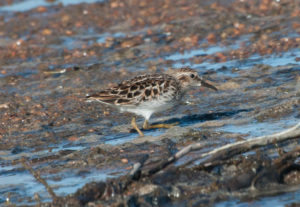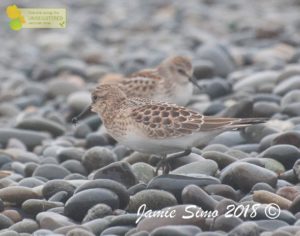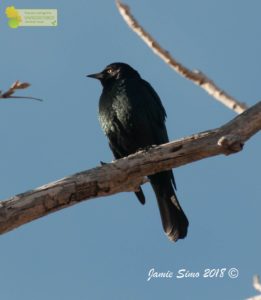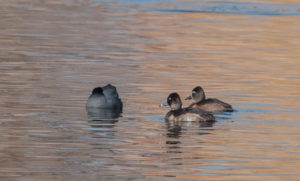September is a great month to look for migrants and this past Saturday at Lagerman Agricultural Preserve didn’t disappoint on that count. We also welcomed our newest employee, Stephen Chang, to the FRBC team on this bird walk. Welcome, Stephen!
Unlike spring migration where birds are in a rush to find nesting territories, fall migration is a more leisurely affair, so we saw stopover species that breed farther north, Colorado breeders, and species that winter along the Front Range. In the stopover species category, we saw both Least and Baird’s Sandpipers. Least Sandpipers are the smallest shorebird species in the world and are long-distance migrants breeding in the arctic and wintering in Mexico and Central America. In addition to size, Least Sandpipers can be distinguished from the other small sandpipers classified as “peeps” by their yellow legs (the other four “peeps,” Western, Semipalmated, Baird’s, and White-rumped Sandpipers, have dark legs). In September, Least Sandpipers are still in breeding plumage and appear rusty with a couple of paler stripes down the back.
Baird’s Sandpipers are also long-distance migrants that breed in the arctic, although they travel even farther in winter than Least Sandpipers and fly all the way down to Chile and Argentina. Perhaps because of this they have long wings that extend slightly past their tails. They tend to look somewhat “scaly-backed,” especially juveniles, with dark-centered feathers on their backs edged with a paler tan. Their breasts are also tan with pale striping that doesn’t extend onto the clean white of their bellies and flanks.
For species breeding in Colorado, we saw a number of Brewer’s Blackbirds. Brewer’s Blackbirds are often found in agricultural areas. Males are an iridescent black with a pale eye. The pale eye, lack of red shoulder patches, and thinner bill, distinguish them from the similar male Red-winged Blackbird. Female Brewer’s Blackbirds are brown with a dark eye and can be distinguished from the similar female Brown-headed Cowbird by being darker, larger, and having a thinner bill.
Finally, we were fortunate to see the first vanguard of several species that winter in our area, including the Ring-necked Duck. Despite being named for the ring around their neck, which is usually only visible at close range, Ring-necked Ducks have grey bills tipped with black and ringed with a band of white. Both males and females have peaked heads. Females are brown with a darker brown “saddle” on their backs and a white patch near the base of the bill. In non-breeding plumage, males can be picked out from females by their dark breasts, darker heads, and yellow eyes.
In all, we saw 28 species. Join us next month at our Boulder location when we check out Barr Lake State Park and visit Bird Conservancy of the Rockies’ banding station.
Lagerman Agricultural Preserve, Sep 14, 2019
28 species (+1 other taxa)
Canada Goose 16
Blue-winged Teal 4
Cinnamon Teal 1
American Wigeon 24
Mallard 6
Green-winged Teal 2
Redhead 3
Ring-necked Duck 3
Ruddy Duck 3
Pied-billed Grebe 5
American Coot 12
Killdeer 6
Baird’s Sandpiper 4
Least Sandpiper 2
Short-billed/Longbilled Dowitcher 7
Ring-billed Gull 57
Double-crested Cormorant 13
American White Pelican 2
Great Blue Heron 2
Turkey Vulture 2
Osprey 1
American Kestrel 2
Say’s Phoebe 2
Barn Swallow 11
Lesser Goldfinch 3
American Goldfinch 2
Vesper Sparrow 4
Western Meadowlark 4
Brewer’s Blackbird 6






Comments
Write Comment